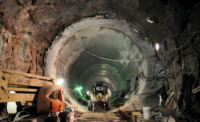To upgrade and expand sustainable power for its plant that treats 3.2 million gallons of wastewater daily, the Great Neck Water Pollution Control District’s project team had a tall hurdle to clear—keeping the facility that serves 25,000 Long Island residents in operation throughout construction.
The multiprocess wastewater treatment plant in Great Neck, N.Y., has upgraded other features in the past, but the current $15-million project, which began in late 2018, will have an outsized impact—harnessing the facility’s normal operations to generate power for half of its total energy use.
The work entails adding a new 75-kW co-generation microturbine; replacing anaerobic digester equipment, which produces methane gas by breaking down waste, along with related electrical and mechanical components; and building a commercial grease waste intake system to not only generate revenue but also to support supercharged waste-to-energy technology.
As the team tackles the project’s various elements, it has to keep the facility running at full capacity, says Chris Murphy, plant superintendent for the Great Neck district. “Whenever you’re doing construction at a wastewater treatment plant, you do not get relief from your regular treatment requirements,” he says. “That’s one reason this has been a very exciting construction project. It isn’t a typical municipal upgrade.”
The team chose a staged installation strategy for the heart of the project—replacing Great Neck’s three anaerobic digester systems, says Dan Capano, project manager at Gannett Fleming, which is both design engineer and program manager. The work began last year, taking off line one of the old digester systems—Unit No. 3—to start its upgrade and rehabilitation, he says. “The staging ensures that the plant’s operations are not compromised,” he says.
The key transition in the program will take place early this spring, when a new No. 3 digester system comes on line, says Jiangzhao Zhang, Gannett Fleming project engineer. “Once we turn on the new digester No. 3, which has better heat and mixing systems with more capacity, then we’ll have larger capacity to take more solid waste, and we will have the capacity to take the old 1 and 2 digesters off line.”
Before making the switch, the team will check that the new higher-capacity digester No. 3 system can not only process wastewater sludge, but also generate ample methane gas to power two existing microturbines Gannett Fleming had installed in an earlier 2014 project.
When all systems are go, the team will start upgrades to the other digester units, according to Capano. “If all goes well, we take them off line in April and bring the new equipment back on line in June,” he says.
Staging the installations also means Gannett Fleming has to coordinate overlapping schedules as contractors focus on their pieces of the puzzle, Capano says. “It’s a challenge when you have jobs with multiple prime [contractors] on site.”
Other project team members include WHM Plumbing and Heating, JVR Electric, Harbor Mechanical, and D&B Engineers and Architects.
Optimizing Potential
The new project goes beyond upgrading older digester systems and adding new capabilities, Murphy says. It’s a concept that has been on the Great Neck district’s radar for more than a decade, he adds.
“This is usually one of the more ignored parts of a plant because of the cost,” he says. “It’s expensive to perform these upgrades, but we didn’t want to just return them to the same capacity without getting additional efficiencies.”
Upon its completion in mid-2020, the fully upgraded facility will be able to process 5.3 million gallons per day from Great Neck and surrounding communities, not only handling the regular residential and commercial wastewater flow, but also adding capacity to handle restaurant grease waste that will be hauled in from throughout the region, Murphy says.
“We wanted a way to have the new digesters become more of a fuel source for us, as well as a potential revenue source,” he adds, with haulers paying the district to unload grease, and that waste in turn helping the system generate more methane to power its microturbines.
The added revenue potential is a major benefit of the project, because even though the Great Neck district is a self-regulated utility with its own taxing ability, operations and budget, it still has to go through its home municipality for bond financing, Murphy says. “It helps to say, ‘We need to bond this much, but it’s only going to cost taxpayers this much,’” he says.
The $15-million project budget includes $14 million for the digester upgrades and new grease receiving facility and $1 million for the third microturbine, Murphy says. But the new microturbine, on which the team completed installation earlier this year, came in 26% under budget at less than $800,000, he adds. The project also tapped into government grants, including $500,000 from the New York State Economic Development Council in 2016. “These are incredibly grant-able projects,” he says. “When we generate energy on site, we free up energy capacity for the community.”
Funding Tapped
The work also got help from former state Sen. Elaine Phillips (R), a Nassau County legislator who helped shepherd a $10.5-million grant through New York’s Transformative Investment Program. “I applaud the district’s … business-like approach to running the municipal plant and focusing on operational efficiency, increased revenue, all while being environmentally safe,” said Phillips, who lost her re-election bid in 2018.
The Great Neck plant has had various major upgrades in its 106-year history, steadily increasing capacity and reducing environmental impact, such as replacing chlorine disinfection systems with newer UV processes.
The plant uses four treatment stages—preliminary, primary, secondary and advanced—to remove solid waste via physical and biological processes, along with other methods to reduce toxicity of remaining liquid sludge. Digester systems are a central function in the advanced stage, stabilizing sludge by reducing “volatile content” and pathogens—a process giving off the methane that powers the microturbines on site.
“Anaerobic digesters are usually the second-largest budget item in a treatment facility,” Murphy points out. “They’re like a stomach—you have to feed them, and you have to keep them heated to reduce the amount and toxicity of the solids to break them into water and gas.”
Greasing the Skids
The project’s biggest new feature—adding a grease intake unit—offered another set of challenges, in part because it’s not in the standard wastewater treatment playbook, Murphy says. Only a few U.S. plants have added such systems because they require substantial new infrastructure to take in waste from trucks, collect payment from haulers, upgrade digesters to handle grease in addition to wastewater and channel the additional methane to onsite co-generation units.
“Grease haulers were very positive about the possibility of having a [reuse] facility in Nassau County.”
– Chris Murphy, Plant Superintendent, Great Neck Water Pollution Control District
For Great Neck, adding grease processing capacity has meant constructing a new 2,500-sq-ft digester utility building that will house the truck receiving station and associated electrical equipment, Capano says. Construction of the new building began last year and now is 75% complete, he says.
“As we start on the 1 and 2 digesters, work on the [building] is continuing,” he says.
Disposing of commercial grease is itself an environmental challenge, with only a handful of discharge locations for trucks that collect such waste from thousands of restaurants and other businesses in the New York metropolitan area, Murphy says. Great Neck had Gannett Fleming conduct a marketing analysis of the need for an additional disposal site, he says. “There is a tremendous amount of grease traveling up and down the roads every day, and only a few spots that take it,” he says. “The haulers were very positive about the possibility of having a facility in Nassau County.”
The new facility’s features include a docking station that hooks up grease haul trucks to the collection and storage system; automated driver authentication; volume metering and payment systems that will generate bills of lading and invoices; and integration steps to connect with the existing plant SCADA (supervisory control and data acquisition platform). “We didn’t want two systems,” he says. “That gets cumbersome.”
Developing a solution with automated capabilities was another prime goal, Murphy says. “We can have one staff member there when the truck is unloading just to supervise, but everything else, including having the systems cleaned and flushed, could be done by the SCADA system,” he says.
Improved Digestion
Taking in commercial grease for the first time not only means adding the intake station, but also an upgraded digester design, Murphy says. “Your anaerobic digester needs a good mixing and heating system and the ability to retain a lot more of the methane gas,” he says.
That work includes upgrading various mechanical and electrical components, such as pipe, heating, pump, mixing, sensor and sludge withdrawal systems, Zhang says. All of that will connect to the three existing 238,000-gallon, 40-ft-dia concrete tanks, which will stay in place during the work.
Once all three new digester systems are on line, the plant can greatly boost methane generation because bacteria that normally feed on wastewater can get a lot of mileage out of grease, Murphy says. “Grease is a very soluble food source for anaerobes,” he says. “It allows them to destroy more solids than if it was just sludge, which requires less energy. And it also lets them generate more methane.” The new digesters can produce up to 50 cu ft per minute, or cfm, of methane, above the current 12 to 20 cfm today, Zhang adds.
Supercharged Results
All of that extra methane will have somewhere to go with the project’s other big feature: the third microturbine. While the two existing microturbines today power 20% of the plant’s electricity and about 80% of digester process heating needs, the new systems—grease intake, upgraded digesters, boosted methane levels and a powered-up third microturbine—will help generate 195 kW to cover half of total energy use and 100% of digester heating.
Most wastewater plants with anaerobic digesters use a small portion of methane by-product as energy, usually in boilers or digester heating, with the rest flaring off as waste, Murphy says. The new system plant will capture far more of the methane as energy, while also accruing savings from drawing in less power from the electric grid, he adds.
“We’ll have copious amounts of electricity on site, including 100% of our heat in winter, from waste gas,” he says. “It basically is like having a free gas pump for your car.”
By July, the project team expects to have all upgraded digesters in place, the grease intake system operating, and the third microturbine firing at full capacity, Capano says. It also aims to meet another goal: completing the work without community complaints. That’s no small task considering there’s an apartment complex across the street, he says.
“Odor control has been a big part of our construction activity coordination,” he adds. “We have had successful mitigation procedures in place. There were no odor complaints during the digester replacement.”









Post a comment to this article
Report Abusive Comment